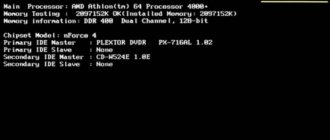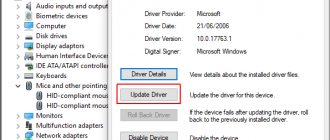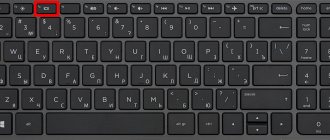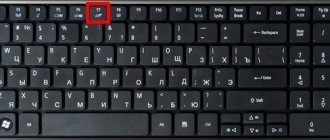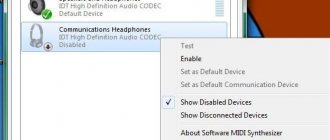The world is increasingly immersed in wireless technology. Laptop manufacturers improve their technology every year. With growing progress, people also have an increasing number of questions that arise in the process of using a computer. Today we will look at one of these questions: how can you turn on Wi-Fi on a laptop? It would seem that what is so difficult here? Unfortunately, the older generation cannot cope with this problem without outside help. Therefore, we decided to tell you in simple terms about all the simple ways in which you could solve the problem of lack of Wi-Fi on your computer.
Turn on Wi-Fi using keys or a button on the case
There are two simple options for turning on WiFi, which you can use if you find that there is no wireless connection on your laptop, and therefore the Internet will not work. The first launches the Wi-Fi module using a key combination, and the second thanks to the button located on the case. Let's look at these methods in more detail.
We activate Wi-Fi with the button on the case
There are laptops in which the manufacturer builds a separate Wi-Fi button for convenience. But on older models there may be a small slider instead of a button. Therefore, you have to carefully inspect the entire case for the presence of a button or slider. If you find it, try turning on Wi-Fi, and if not, then read the second option below.
Launch WiFi with a keyboard shortcut
You can also turn it on by pressing two keys simultaneously. Unfortunately, manufacturers do not have a common vision on this matter, so you need to press different buttons on different models. We will give the key combinations that are used in computers from various manufacturers:
- Taiwanese company Acer – press “ Fn ” and hold down “ F3 ”.
- Chinese company Lenovo - press “ Fn ” and “ F5 ”.
- American companies HP - combine “ Fn ” as well as “ F12 ”.
- South Korean manufacturer Samsung - two options: “ Fn ” + “ F12 ”, and “ Fn ” + “ F9 ”.
- AsusTek Computer Inc Asus – combination of the “ Fn ” and “ F2 ” buttons.
Sometimes a Wi-Fi icon can be drawn on any button in the top row of the keyboard. In this case, there is a possibility that when you press “ Fn ” and hold it, press the button with the Wi-Fi icon. When pressed this way, the Wi-Fi module should start.
We activate Wi-Fi programmatically
Software launch is performed in several ways: through the device manager or through the network control center. Now we’ll take a closer look at how to enable Wi-Fi on a laptop using these methods. The methods are also suitable for netbooks.
How to start Wi-Fi using Network Sharing Center
- Press “ Win+R ” to quickly get to the “ Run ” window. Enter the command “ ncpa.cpl ” and click “ OK ”. The “ Network Connections ” window will pop up, where all the adapters on this PC will be highlighted.
- You need to pay close attention to the adapter named “ Wireless Network ”, if it is grayish in color, it means it is disabled. Right-click on it and select “ Enable ”. That's all, let's try to connect with the router. Suddenly, after turning on the module, the laptop does not find any Wi-Fi network at all, then read the article about why the laptop does not see the WiFi network.
Launch it in Device Manager
The Wi-Fi module in the device manager may turn off due to some kind of failure. With this option, in the “ Network Connections Wireless Network module shortcut will be absent altogether. Well, let's check it out.
- Run ” window again Win and R ” at the same time. Enter “ devmgmt.msc ” there and click “ OK ”. Device Manager we need will appear . You can also open it by right-clicking on “ My Computer ”, “ Properties ”, “ Device Manager ”.
- We look for the “ Network adapters ” section and expand it. A list will appear in which you need to activate the Wi-Fi module. To do this, hover over it (in our case it is called Realtek 8821AE Wireless LAN....), right-click and select “ Enable ”. After 20 seconds, you can try to connect to the network.
Through the command handler “cmd”
How to replace a Wi-Fi module in a laptop: what it looks like on laptops from different manufacturers
To use the “cmd” program handler you must:
- Use the search function for programs and files;
- Set keyword as "cmd";
- Start processing as administrator;
- Use the "netsh interface show interface" command to view interface information;
- Add “netsh interface set interface name=”wlan” admin=ENABLED“;
- Run command;
- When finished, you should call up the interface information again.
How to start Wi-Fi on Windows 10
We will show you the fastest way to turn on Wi-Fi on Windows 10.
- In the lower right corner of the screen where the time is displayed, left-click on the Wi Fi icon and select “ Network Settings ”.
- A window will appear, here click “ Wi-Fi ”, drag the slider at the top to the “ On ” position. Done, after startup the laptop will scan and display all Wi-Fi networks that are available. If this does not happen, then it will be useful to read the article: why WiFi stopped working on a PC.
How to turn on Wi-Fi on Windows 7
Now we will show you the most optimal option for running Wi-Fi on a laptop with the Windows 7 operating system.
- Let's start with the fact that you need to go to “ Start ”, “ Control Panel ”. Here among the icons we find “ Network and Internet ”. Next, click on the line “ Network and Sharing Center…. "
- On the left side, at the top, you will see “ Changes adapter settings ”, enter it.
- A window will open containing all the modules available on the computer. You select the “ Wireless Network Connection ” module. We hover the cursor over it, right-click, from the available list that appears, click “ Enable ”. The label will change from pale gray to bright, and an icon will also appear in the lower right corner.
What to do if you can't connect
How to enable Wi-Fi on Windows 8 - network settings
It happens that for no apparent reason the connection to the network does not occur. How to connect Wi-Fi on a laptop in such a situation?
Connection problems
The reason may be a problem with the wireless router settings. Then the laptop does not see the Internet connection at all. The situation can be corrected by taking certain steps, namely:
- Reboot the laptop operating system and router.
- Enter the “Settings” menu.
- Click on the “Networks” item.
- Open the “Wi-Fi” line.
If a password request appears, it means it is possible to connect to the network.
Often the device requires setting up a communication channel. Adjusting your router settings will help your laptop find an access point.
When a window appears with the text “Saved, WPA-WPA2 protection”, you need to:
- Open the “Connection” tab;
- Click on the “Change” button;
- Enter your password.
If the problem is in the router settings, then you should:
- Thoroughly study the instructions supplied with the laptop. Particular attention should be paid to the type of encryption and network mode.
- Enter the address 192.168.1.1 into the address bar and enter the “Settings” of the router. The system will require a login and password. They need to be entered.
- On the website that opens, enter the router control panel. There you can configure it. The instructions should be strictly followed. You can start with the standard mode. When the router is configured, you need to save the result and restart the computer.
A Wi-Fi access point is a wireless opportunity to use the Internet. If a cable connection is provided by only one device, then several devices can be connected in parallel within the range of the router.
The question of how to connect a laptop and other gadgets to Wi-Fi is easily resolved. To do this, just purchase a router and connect it to the cellular operator you are using (Rostelecom, MTS, Dom.ru, etc.). The router can distribute Wi-Fi in the 2.4 GHz band and higher. A good data exchange rate will allow each device to operate in optimal mode.
Turn on Wi-Fi on a desktop PC
It is much more difficult to turn on Wi-Fi on a desktop computer than on a laptop. While almost every laptop has a built-in Wi-Fi module, the computer does not have it. This situation can be easily corrected; you just need to buy a Wi-Fi adapter and somehow connect it to your computer.
There are two types: one adapter is external, it connects via USB, the other is internal, it must be inserted into the motherboard. After purchase, we connect the adapter to the PC, install the drivers, they are usually included in the kit. Next, we scan available networks and connect.
We update outdated drivers on the Wi-Fi adapter
One day you will discover that Wi-Fi does not work on your laptop. There are many reasons why this happened, but first of all, we recommend that you check if everything is okay with the drivers on the wireless module. After all, they could fly off or simply become outdated. Now we will show you how to check whether the driver needs to be updated:
- Press " Win and R ". Paste this line - “ devmgmt.msc ”. Click " OK ". We get to the “ Device Manager ”.
- Find “ Network Adapter ” and expand it. From the list, select the module where it says “ Wireless LAN ”. Double-click on it.
- A window will pop up where you need to click on the “ Driver ” section in the top row. Here you will see the version of the driver that is currently installed on the computer.
Now find the official website of the manufacturer, compare your driver with the driver on the website. Or, to be sure in any case, download the drivers and install them again. Before installation, we recommend that you completely remove the old driver from your PC. After this procedure, we try to turn on the wireless module on the laptop.
Possible problems and their solutions
When connecting a laptop to a router, users often encounter certain problems that can be quickly resolved using the instructions.
You can fix Wi-Fi problems yourself
Weak, unstable signal
The situation can be easily corrected by moving the router to another location. The signal may be encountering too many obstacles.
Endless network address acquisition
The main reason is errors in the settings and encryption methods. It is also possible that the user has incorrectly selected the connection security type. To solve the problem, you need to use WPA/WPA2, as well as AES and NKIP automatic switching. These encryption methods should solve the problem.

